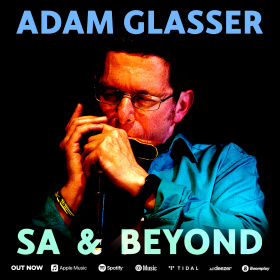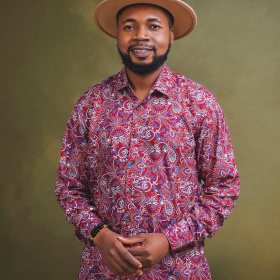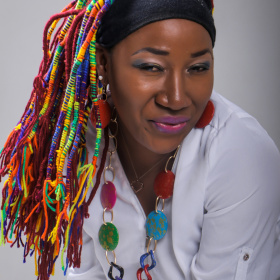Takamba music in Mali
By Caroline Trouillet
This text provides an overview of Takamba music in Mali.
 Songhai Marriage in Bamako
Songhai Marriage in Bamako
Origins: the story of a Tamasheq griot in Temera
Takamba music and dance originated from the Songhai Empire in the 15th century, with Gao as its cultural and commercial capital. Before being known as Takamba, this music was performed by Tamasheq griots and blacksmiths of the Gao region to celebrate the end of harvest, welcome and encourage warriors back from the battle and to praise noble families. The griot, in a sitting position, would play the tehardent, also known as the kurbu by the Songhai people or more commonly ngoni. Takamba has gradually evolved through contact with Songhai populations enriching the cultural lives of noble families living in the Tamasheq camps. The settlement of the Tamasheq population in a mixed neighbourhood led to a cultural fusion, the music of which, Takamba, was one form of expression.
The word ‘Takamba’ has its origins in the village of Temera, situated between Timbuktu and Gourem. People of the region spoke of a Tamasheq master and his griot who were camping one day near Temera. When hearing the sound of the tehardent, the Songhai villagers approached the two men. Fascinated by the beauty of one of the women, the master wanted to lend her his hand. His griot spoke to the woman, saying "takamba", meaning "take the hand". This is how the term Takamba was born in Temera, a village renamed after the music. Another version tells the story of Mahamana Zaou Sadio, a Songhai who invited a Tamasheq griot to his village to celebrate his daughter’s wedding. Seduced by the languorous music, the Songhai began to solicit Tamasheq griots to woo women.
Until the 1960s, Takamba was sung and only accompanied by the tehardent, joined sporadically by hand clapping as percussion. Dancing was subtle and performed while seated. Takamba spread from this village to evolve into festive music during Songhai social and religious gatherings. For both men and women, it offered an opportunity to meet and engage in subtle gestures that were forbidden in everyday life.
Contemporary Takamba
In the 1970s, Takamba, through a generation of Songhai and Tamasheq musicians, developed into today’s popularized form: a group composed of two ngoni players (bass and solo), the calabash player, the lead singer and dancers. Ahmed Ag Assalat, considered to be one of the greatest contemporary Takamba inspirations, is a Tamasheq ngoni player. Known as the ‘grand griot’, he introduced his nephew Sahaloun (or 'small griot') to his art. In their family, Yehia Mbala Samake has become a leading figure as an ngoni player. He is today the lead player of the group Super Onze de Gao.
Undisputed masters of Takamba music, Haziz Touré, Assalya Samake (father of Mbala Samake) and Agita Moussa Maïga founded Super Onze de Gao in 1979. An enthusiastic Songhai customs officer, Afizou Touré, worked tirelessly to promote and revive Takamba music in the 1980s and 90s. Like a producer, he invested in equipment: microphones, speakers, instruments and recorded Super Onze in 1994. By that time, Takamba had evolved in its instrumental practice and dance and the calabash was introduced alongside the ngoni. Yehia Mbala Samake and Douma Maiga revolutionized the playing of this traditional three-stringed guitar by composing, improvising and sometimes plugging the ngoni into amps. The dancers now stood, focussed on the upper body, with slow movements of the forearms and torso undulating in a playful manner. The songs promoted contemporary values like honour, love and generosity. Takamba dance, primarily entertaining, was a language in itself, performed at weddings, christenings and circumcision ceremonies.
In 1986, Douma Elbaka, the guitarist of the National Orchestra of Gao played Takamba music for the first time on electric guitar. It was a success. Popular musicians from the North, mostly Songhai, added Takamba rhythms to their repertoire, contributing to its wide distribution. This is how the song ‘Wahono’ was popularized by Oumou Sangaré. Baba Salah ( ), guitarist for the singer in 1995, is also in this respect a Takamba precursor, experimenting with the music as a non-griot while studying at the National Arts Institute in Bamako. His debut solo album, Gao, included two Takamba songs. Regarded today as one of the best guitarists of his generation, he is the cultural ambassador of the Sahel in the same way as Ali Farka Touré, Afel Boukoum, Habib Koité, Sidi Touré, Khaira Arby or the Tamasheq group Tartit. These renowned artists have popularized Takamba music and its dance throughout Mali as a source of artistic experimentation as much as music for religious and social celebrations.
International reach
In the 2000s, Takamba spread internationally through the success of Super Onze at the Festival sur le désert of Essakane. The group was then composed of Issa Touré (vocals), Yehia Samaké M'balah, Ahmed Ag Assalat or Aboubekrim Yatara (ngoni), Mahamadou Balobo Maia and Aliou Saloum Yattara (calabash), Attaher Yatara (vocals) as well as Fatoumata Sarre and Ousmane Yattara (dancers). Many musicians (including British artists Robert Plant and Justin Adams) were impressed by their performance at the third edition of the festival in 2003.
In 2008, Super Onze participated in the Sfinks festival in Belgium. Their meeting with Dutch DJ Horst Timmers (aka MPS Pilot) allowed Takamba to shine in Europe. At the Essakane festival, the DJ was mesmerized by the Takamba rhythm and its off-beat sound. He was already thinking of how to incorporate an electro beat to accent the melody. Timmers met the group again a few years later, recorded their music and helped promote a new album, released in Europe in 2010 under the label Two Speakers. The DJ also involved the group in a project where Takamba meets electronic music, ‘Future Takamba’ with DJ Lottie, a famous female electronic DJ from the UK, followed by a tour of Holland, Belgium and the Festival de Ségou in Mali.
Today, people dance to Takamba in its native region, as well as in Bamako and other regions of Mali, and neighbouring countries where the Songhai and Tamasheq communities travel (such as Niger, Algeria and Burkina Faso). While the griots of Super Onze de Gao, Super Khoumeissa and Super Foghas perform every week at Songhai weddings, Takamba is also heard in the heart of the capital. In Bako Djikoroni, young people dance every weekend to the Takamba beats performed by popular artists such as Babah Salah, Issa Touré and Omar Konaté.
Musicians from the north have always travelled between Gao, Timbuktu and Bamako. Kazambougou households have for a long time danced to the Takamba beats, recalls the griot Mohamad Sancko. However, it is now deeply rooted in the capital following the crisis in northern Mali. During the jihadist invasion in 2012, some musicians lost their sound equipment and instruments, forcing them into exile. In 2015, the situation calmed down in Timbuktu and Gao and musicians resumed travelling for celebrations, while still focusing on Bamako, where opportunities to live from their music are greater.
The success of the group Songhoy Blues, whose repertoire includes Takamba rhythms, illustrates the paradox of a career sometimes propelled by political strife. During wartime, Takamba, whose history is that of reconciliation within the Sahel, is often mobilized at cultural events where a peaceful political message is issued. In November 2014, an evening entitled ‘Takamba for Peace’ was organized in Gao, bringing together different community leaders. More recently, on the signing ceremony for peace and reconciliation on 15 May 2015, Songhai and Tamasheq danced together to Takamba in front of the Bamako International Conference Centre (BICC). Crowds gathered in numbers, as they had in the past before independence, when political movements such as the US-RDA mobilized crowds through Takamba to spread their messages of liberation and to rally the youth.
References:- Andy Morgan, « Super Onze de Gao – The champions of the Niger bend », 1 April 2011, www.andymorganwrites.com
- « Gao – Soirée culturelle ‘Takamba pour la Paix’ », MaliActu.net, 1 December 2014. http://maliactu.net/mali-gao-soiree-culturelle-takamba-pour-la-paix/
-
Stone, Ruth M. 1998. The Garland Encyclopaedia of World Music, Volume 1: Africa. New York and London: Garland Publishing, Inc.
Discography: - Super Onze de Gao. Super 11. Two Speakers, 2010
- Babah Salah. Gao. Akwaba, 2011.
- Various Artists. Festival in the Desert. World Village, 2003
























Comments
Log in or register to post comments